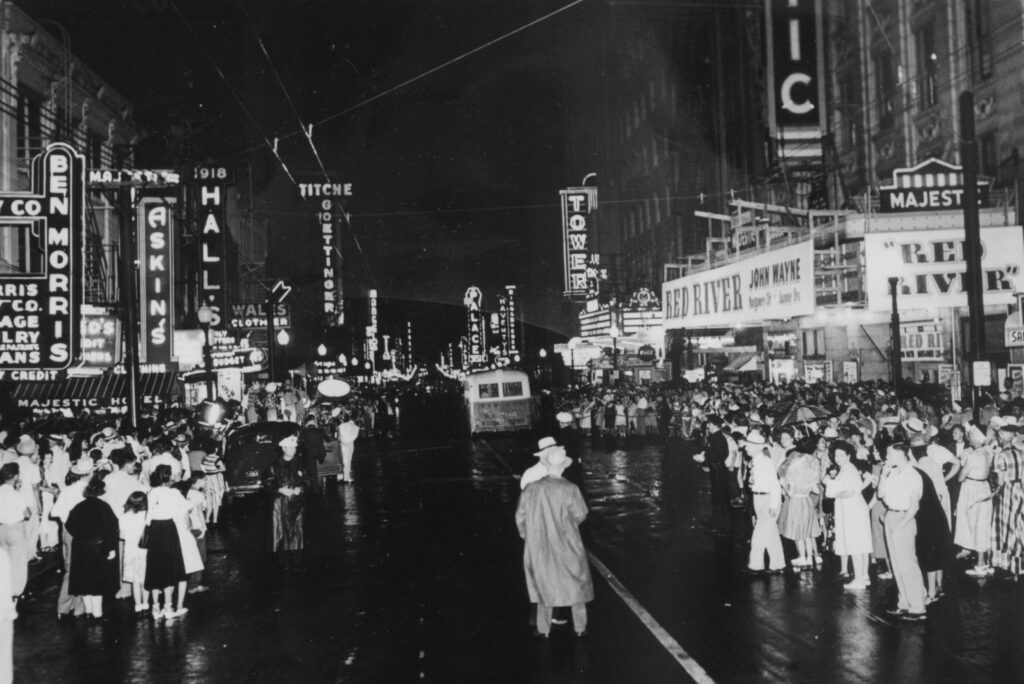The Bright Lights of Elm Street
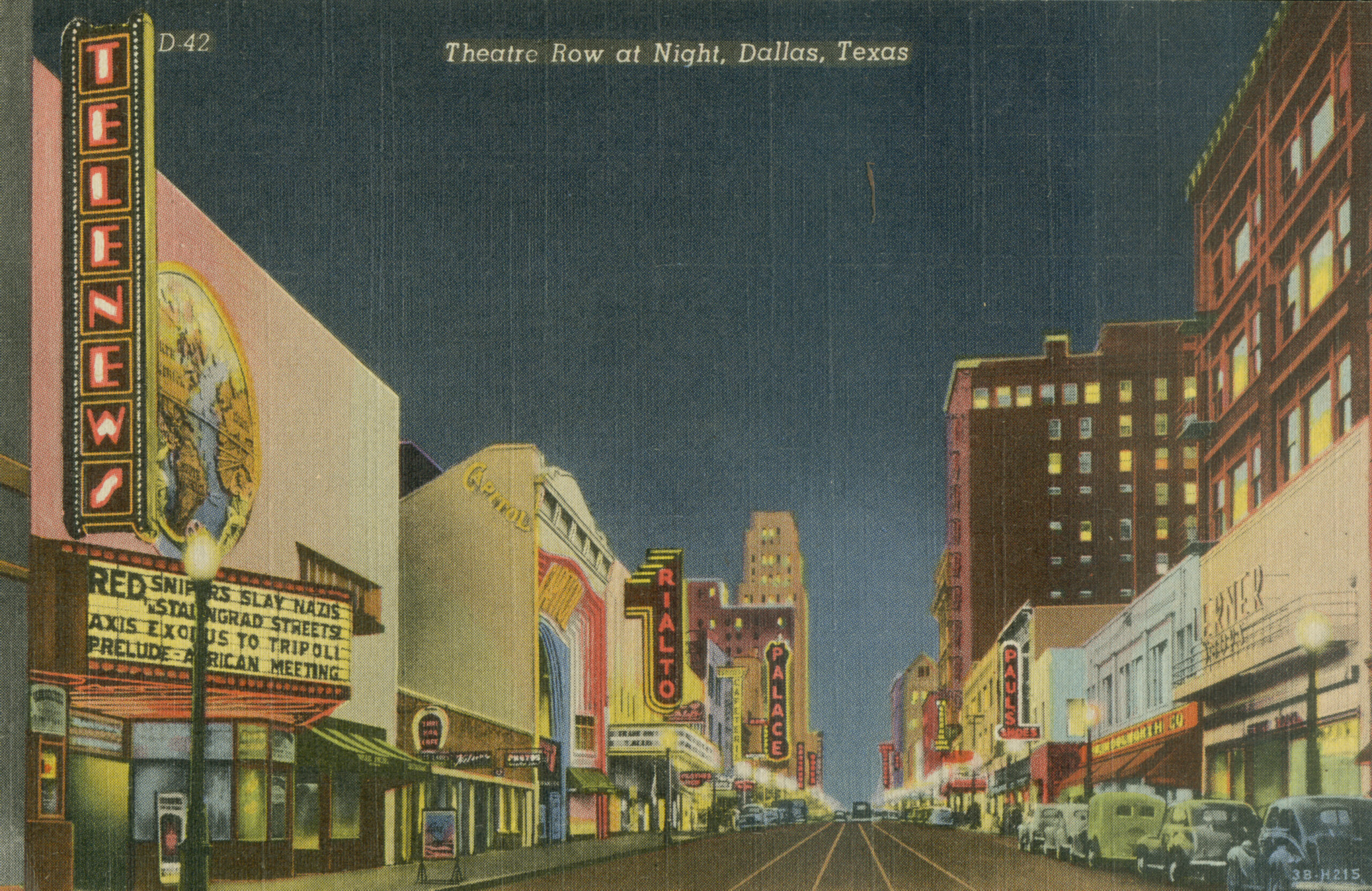 1940s Theatre Row Postcard
1940s Theatre Row Postcard
You wouldn’t know it today, but the 1500 to 1900 blocks of Elm Street were once the bustling entertainment center of Dallas with numerous theatres that lined the street from the 1920s to 1970s. They were uniquely styled and featured brightly lit marquees and colorful neon signs that illuminated Elm Street as people frequented the venues to see the latest show or movie. Unfortunately, the only remnant left of the golden age of theatres in downtown Dallas is the Majestic.
William McIlheran opened the first motion picture theatre in Dallas in 1906. The 350-seat Theatorium occupied a storefront at 1315 Elm Street. At the time, other theatres in Dallas, such as the Majestic and the Dallas Opera House, showed movies but only as novelties to supplement the live productions.
The Theatorium was a huge success, and many other Elm Street storefronts were converted into movie theatres. By the 1920s, the storefront theatres started to disappear as they couldn’t compete with the new lavish and much larger purpose-built theatres being constructed along Elm Street. The Theatorium became the Wonderland and then the Dixie Theatre before it closed in 1928, and then building was demolished.
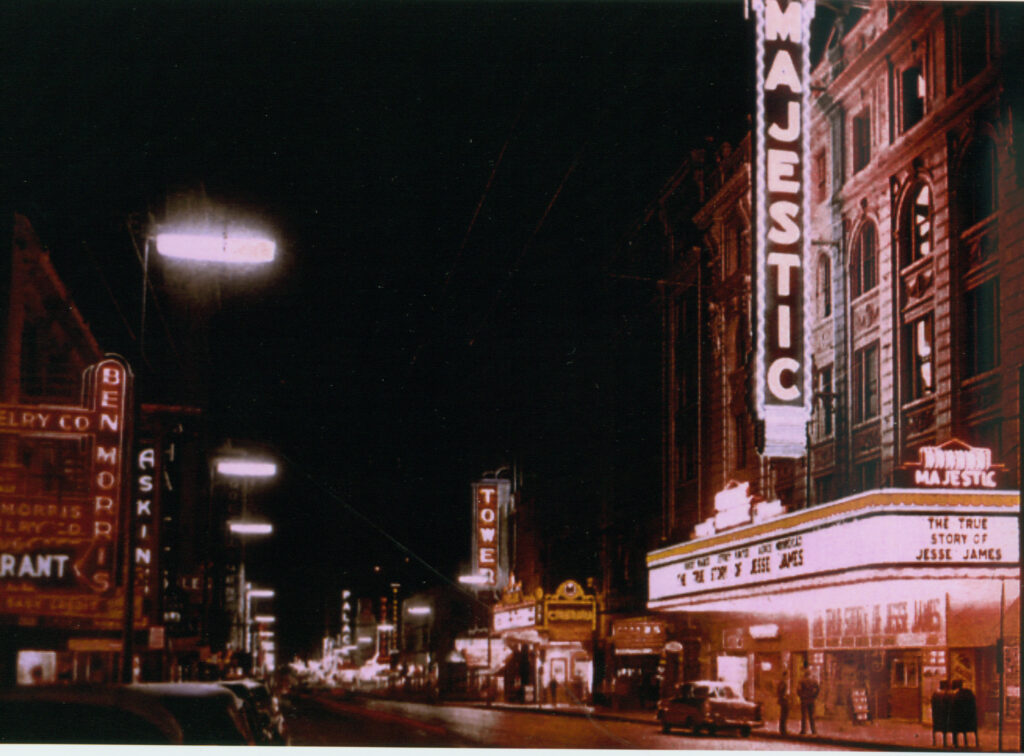
The Majestic we know today at 1921 -1929 Elm Street is the third one to carry the name. Karl Hoblitzelle built the first Majestic in 1905 at the northeast corner of Commerce and St. Paul Streets to serve as a vaudeville theater. After working for the World’s Fair in St. Louis, where he was from, Hoblitzelle formed the Interstate Amusement Company to build theatres across the South. He brought vaudeville acts from the Northeast and even created a circuit for the acts to travel to his theatres.
The first Majestic had an Oriental motif with pagoda-like structures on the roof and an illuminated façade. The interior was impressive with marble wainscotting and mosaic floors. The 1,200-seat auditorium had copious amounts of velvet and gold paneling.
In 1917, the Majestic succumbed to fire; however, that didn’t deter Hoblitzelle, and within a few hours after the fire, he had signed a lease to use the Dallas Opera House, located at the northwest corner of Main and St. Paul Streets. He renamed the opera house the Majestic, and shows continued there while plans were underway for a new and even grander Majestic.
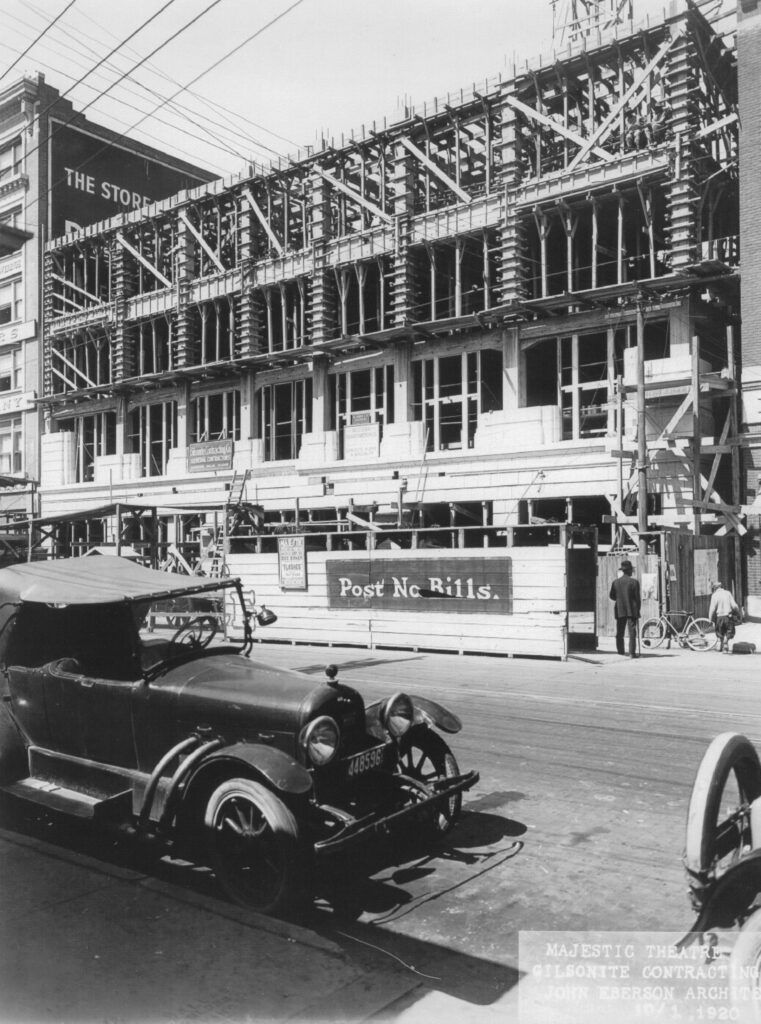
Construction began in 1920 on the new Majestic. Hoblitzelle hired the noted theater architect John Eberson, and no expense was spared, as it was to be the flagship of his Interstate Amusement Company theatre chain. The five-story Renaissance Revival style facade was suitably ornate and expressive to match Hoblitzelle’s vision. A large canopy with incandescent lights underneath stretched across most of the façade, with an eyebrow denoting the main entrance. The seven bays of the upper floors included tripartite windows between engaged pilasters on floors two through four, with single windows on the fifth floor below the cornice line. Separating the windows between the floors were panels with bas-relief swags. Large bas-relief medallions separated the end bays from the center section of the building. Twelve urns topped the parapet.
The interior was even more grand than the exterior, featuring Eberson’s atmospheric theatre concept, which immersed one in a certain décor style. For the Majestic, it was a classical Roman theme. The two-story lobby featured a black-and-white marble floor, Corinthian columns, egg-and-dart molding, cartouches, bas-relief swags, and fretwork. Mirrors, large potted plants, and stuffed peacocks, the symbol of the theatre, enhanced the decor.
The auditorium continued the theme, echoing the Roman Forum with classical details. The focal point of the massive 2,400-seat space was an arched proscenium flanked by massive Corinthian columns. There were three levels of seating arranged in a fan shape and a sunken orchestra pit for live performances. The walls had panels with paintings that featured the Roman theme. The ceiling dazzled with floating clouds and twinkling stars controlled mechanically.
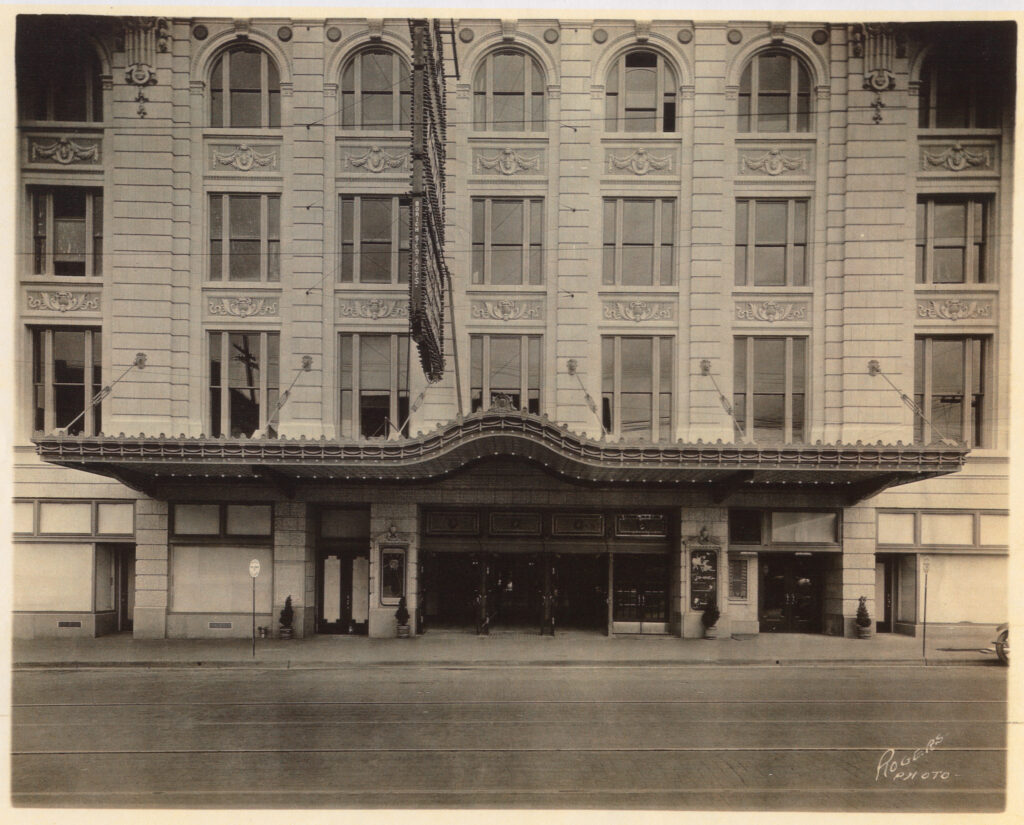
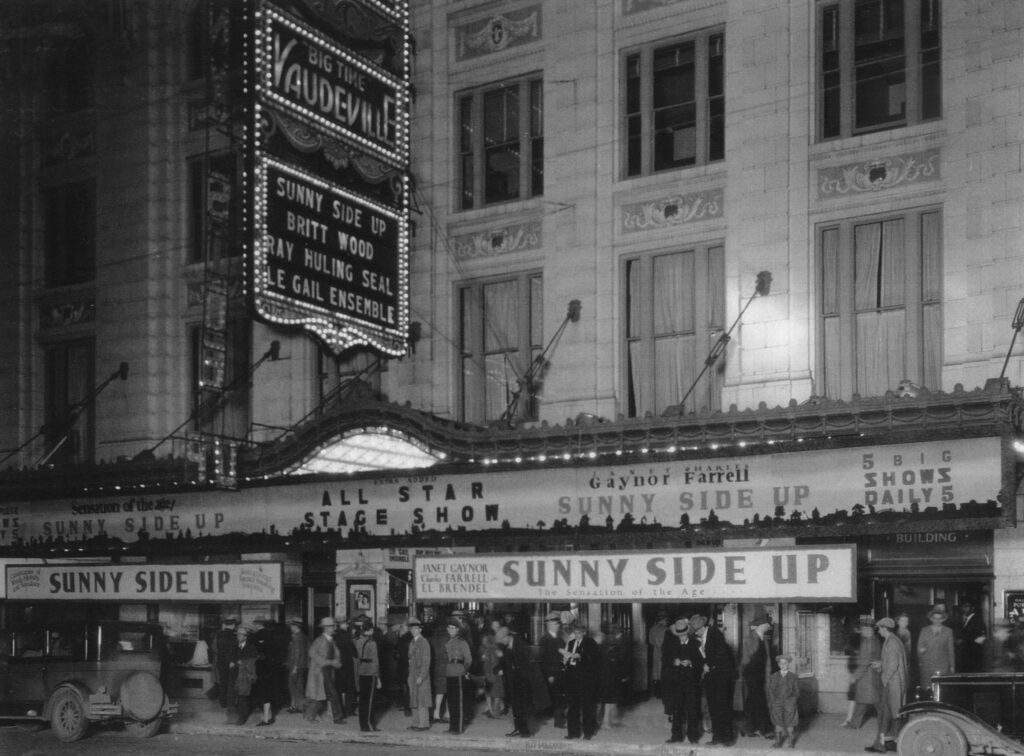
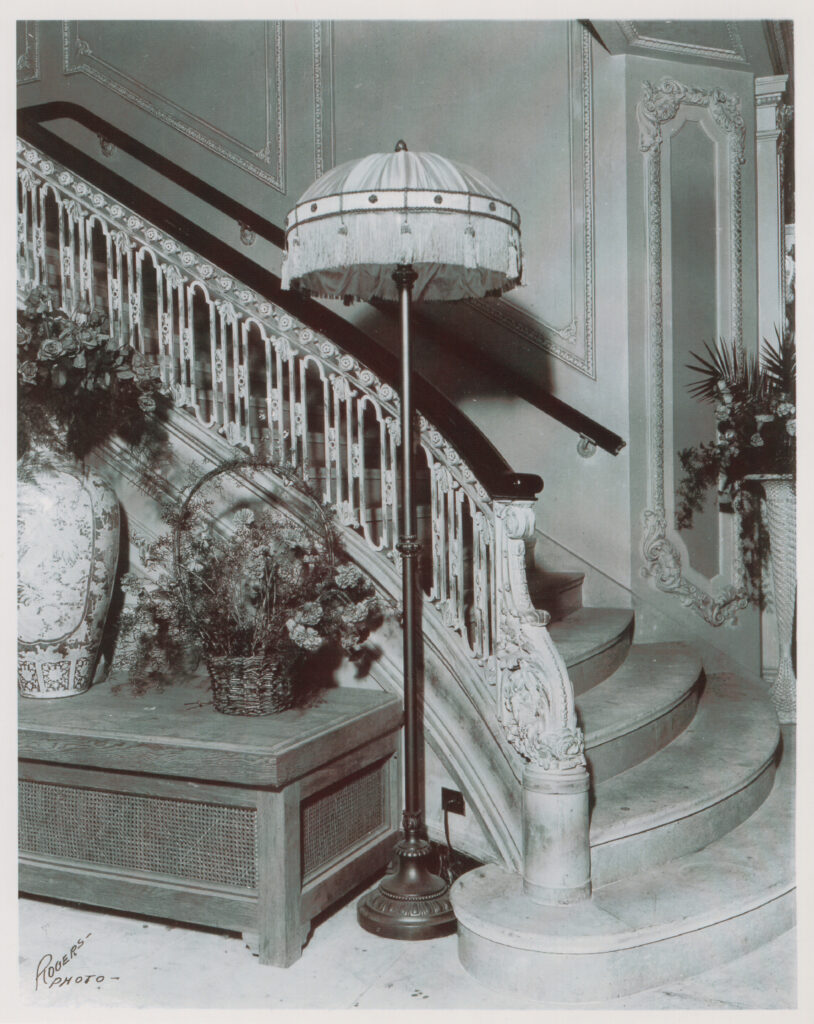
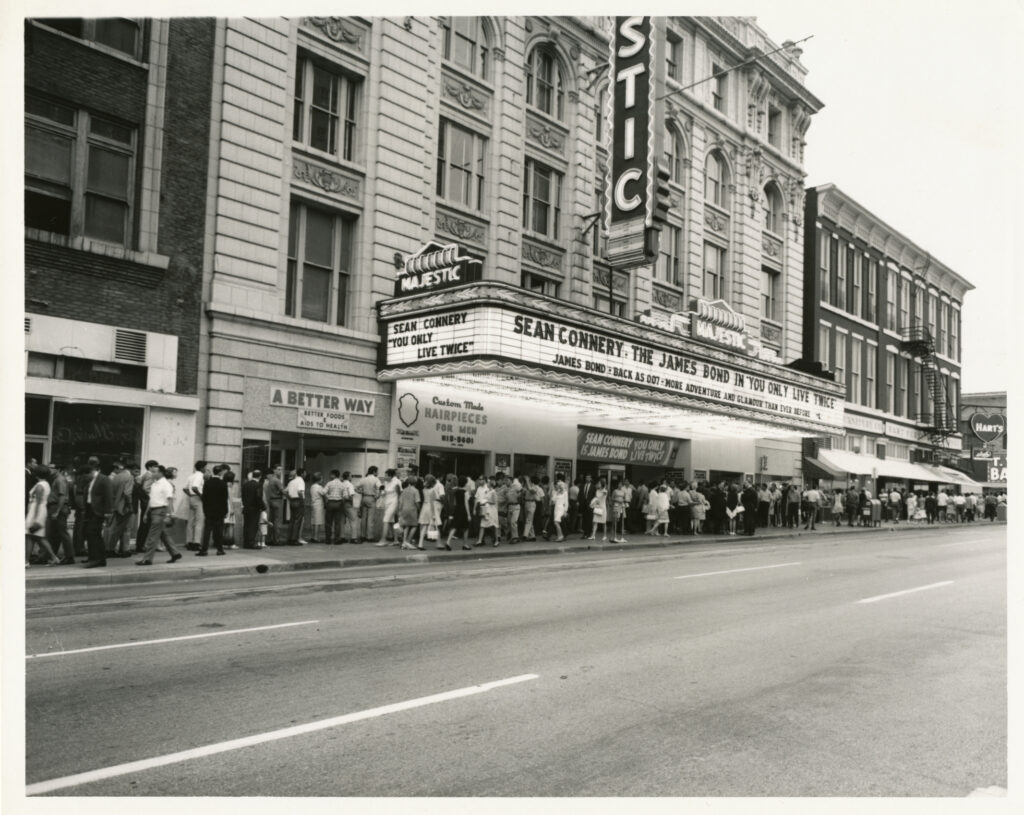
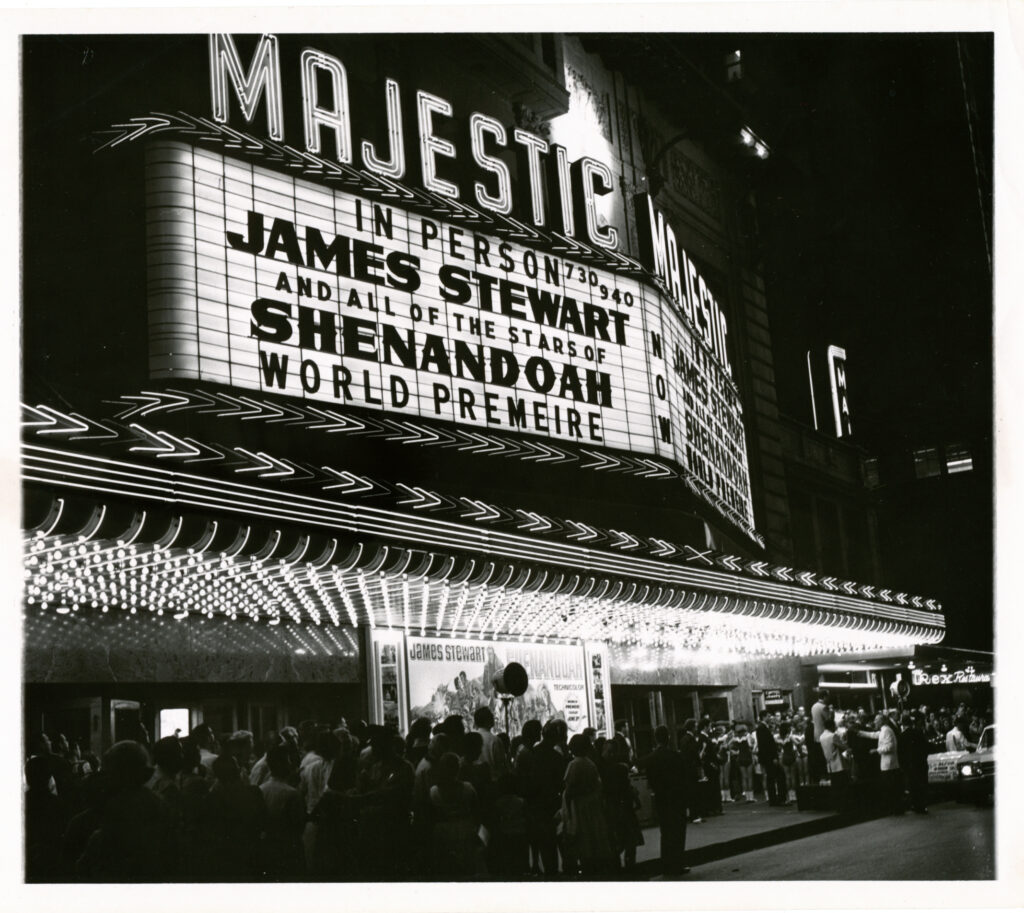
The Majestic was a successful venue and operated until 1973. Over the years, the only changes were to the marquee with enlargements and the addition of various blade signs, one of which was four stories tall and rose above the roof. The Interstate Amusement Company donated the Majestic to the City of Dallas in 1976, and a year later, it was added to the National Register of Historic Places. In 1979, a concerted effort of citizens advocated for a $4 million bond to renovate and reopen the Majestic. The bond passed and in 1983, the Majestic reopened for events and performances. It became a Registered Texas Historic Landmark the same year and then a City of Dallas Landmark in 1997.
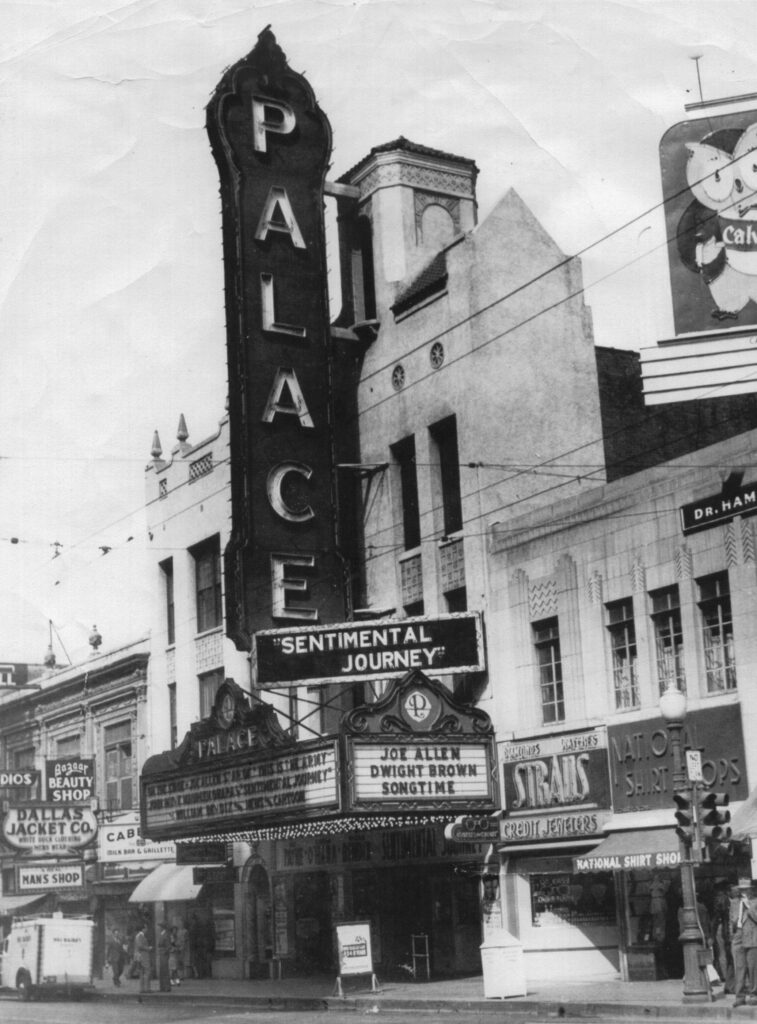
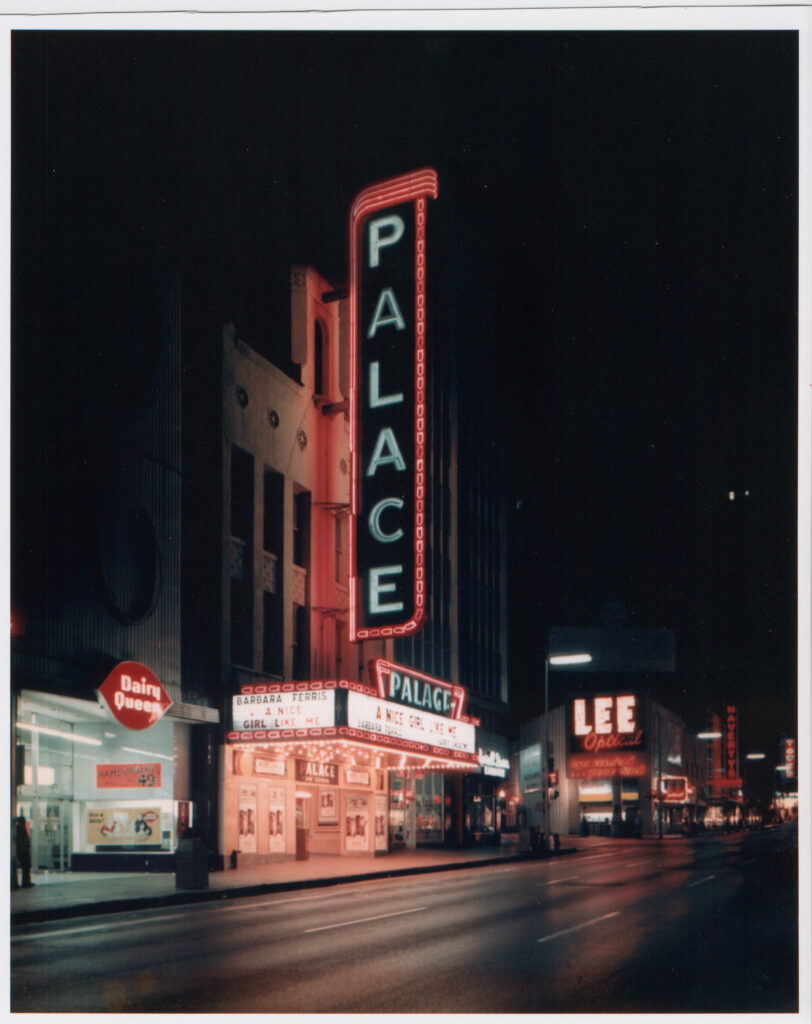
Also opening in 1921 was the Palace Theatre at 1623-1625 Elm Street, owned by the Southern Amusement Company. It was the largest and most spacious of the theatres in downtown, seating 3,000. The design differed from the others in the 1500, 1600, and 1900 blocks of Elm Street, as its lobby led to the auditorium that was turned 90 degrees to the street and behind other commercial buildings.
Other theatres had the auditorium space directly behind the lobby and parallel to the street. With that design, the front façade of the Palace was narrower than the other theatres on Elm Street, hiding the massive size of the auditorium. The three-story Palace façade had a large blade sign with “PALACE” illuminated that extended above the roof tower. The marquee extended over the sidewalk and the two stories above had rows of single windows.
Chicago designer A. Vollmer oversaw the interior, which featured multi-tiered curved seating, a domed ceiling with elaborate relief panels, and a large central chandelier fixture. The balcony required no support to have unobstructed views. Other features included suffused lighting, scagliola columns and balustrades to look like marble, real marble in other places throughout the theatre, and tapestries of silk. The Palace also had a Wurlitzer organ installed on a hydraulic platform which rose dramatically from below the stage.
The Palace was open for fifty years, and when the lease was up, the owners took an offer from a buyer who quickly demolished the theatre. The lot was vacant for more than a decade before the construction of a 50-story tower.
Next door to the Majestic, the Melba Theatre opened in 1922 at 1911-1915 Elm Street. The 2,500-seat theatre was originally called the Hope Theatre, named for silent movie actress Hope Hampton. It only lasted four months before closing because of financial problems encountered by the owner. The theatre quickly reopened as the Melba Theatre owned by the Loew’s chain.
The Melba had an impressive six-story façade designed in the Spanish Renaissance style with Morrish elements. The blade sign on the building was 40 feet tall and had 6-foot-high illuminated letters spelling out “MELBA” in lights. The interior was lavish, and the lobby contained no columns for an uninterrupted view of the wide lobby entirely clad in marble. Ornate staircases flanked each side wall of the lobby. The auditorium featured a large domed ceiling decorated with hundreds of colorfully painted details.
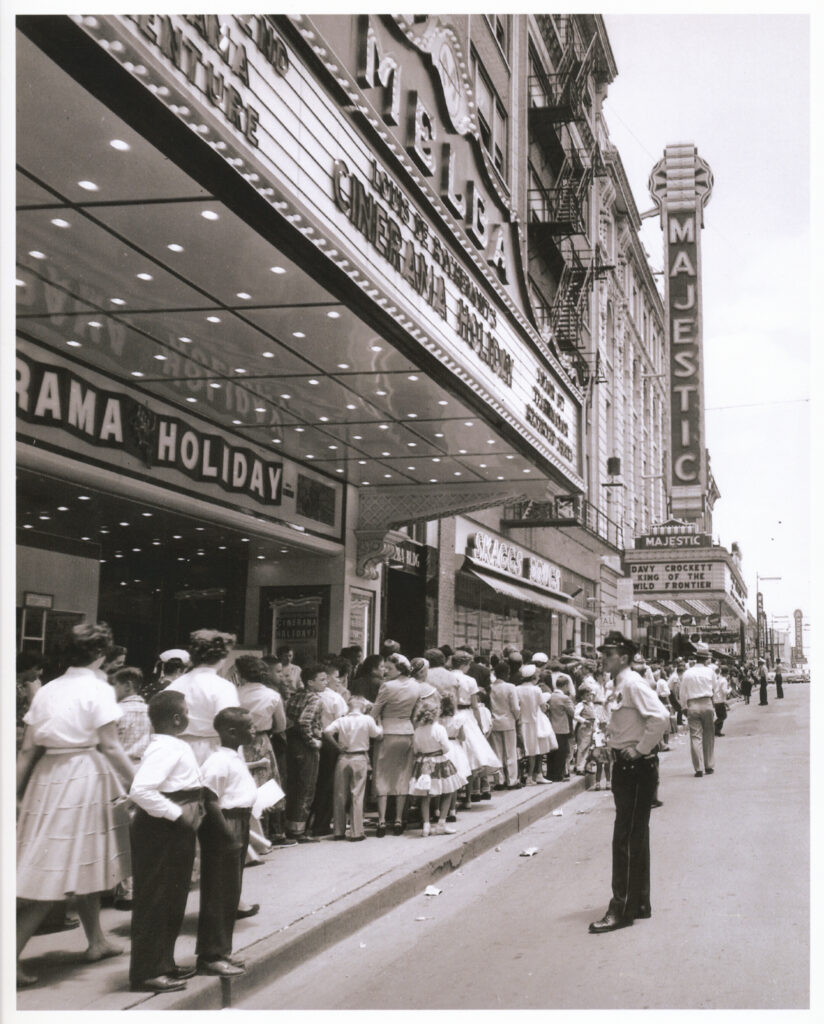
In 1959, the Melba became the Capri. The building received a retrofit in 1970 with six additional screens added. It operated as the Capri 7 until 1976. Demolition took the Capri in 1981 and now an office tower sits on the site.
The Capitol Theatre opened in 1922 at 1521-1523 Elm Street with a seating capacity of 1,200 and served as a discount cinema. The elaborate façade was unique as it featured a concave element above the entrance marquee resembling the inside of a capitol dome. Colorful neon lined the edges of the indented opening with “CAPITOL” spelled out in lights.
The interior featured a colorful fountain, and unlike other theatres of the day, did not have a balcony. The owners claimed that not having a balcony improved ventilation and egress from the building. The theatre was popular with children as it showed low-budget Westerns and monster movies. The theatre declined in the 1950s, closed in 1956, and was demolished in 1959.
Next to Capitol, the Rialto Theatre replaced the Old Mill Theatre at 1525 Elm Street, which was designed to look like a Dutch mill, after the previous theatre closed in 1935. Nena Claiborne designed the new theatre in the popular Art Deco style of the day. The clean, symmetrical facade featured a row of windows above the marquee, a scalloped parapet, and a central blade sign with “RIALTO” emblazoned in neon. The theatre became a second-run movie house in the 1950s, which started its decline. In 1959, demolition took place to make way for a parking lot.
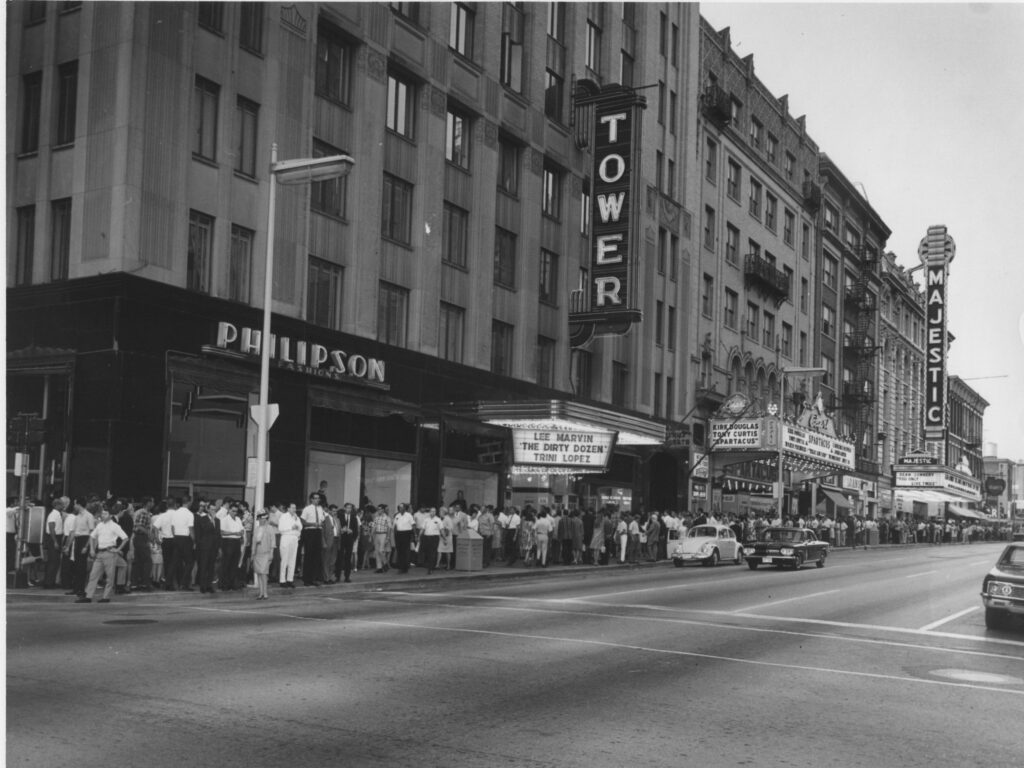
The Tower Theatre opened in 1937 at 1907 Elm Street with 1,320 seats and was located behind the 1930 Art Deco-designed Tower Petroleum building. Theatre access required one to go through the front of the Tower building. There was a small marquee under the “TOWER” blade sign attached to the 22-story façade of the tower. The lobby featured a large built-in aquarium and neon lighting beneath the center handrail for the stairs.
The theatre closed in 1971; however, the shell of the theatre still exists and is used as the vehicular entrance to the 1952 Corgan Tower building, which is now an apartment building.
The Telenews Theatre was one of the last theatres built in downtown Dallas at 1515 Elm Street. While other theatres showed movies, this one focused exclusively on newsreels. It was part of the Telenews chain and opened three weeks before the attack on Pearl Harbor in 1941. The theatre thrived during World War II as Americans hungered for news from the war front.
The exterior of the building was simple, with a flat façade and an asymmetrical design that featured a projecting angled marquee over the sidewalk. Above the marquee was an illuminated blade sign and next to that was a 16-foot diameter bas-relief world map.
The interior could hold a modest 640 and had Teletype machines in the lobby, a broadcasting studio, and a lounge with newspapers and magazines on the second floor. After the war ended, the desire for news dropped and the theatre became the Dallas Theatre. It then focused on more adult performances and burlesque shows before closing and subsequently being demolished.
Large suburban multiscreen movie theaters started opening in the 1960s and began taking away business from the theatres on Elm Street. The new multiplexes were easier to get to, provided ample parking, and offered a range of movies all in one building. One by one, the once-proud Elm Street theatres closed their doors and turned off their colorful marquees and signs, dimming Elm Street before demolition claimed the theatres during the 1980s downtown office boom. Thankfully, the mighty Majestic Theatre has hung on and still shines as the last of the once grand theatres that dotted Elm Street for blocks, entertaining thousands every night under the glow of the gleaming marquees and neon signs.
